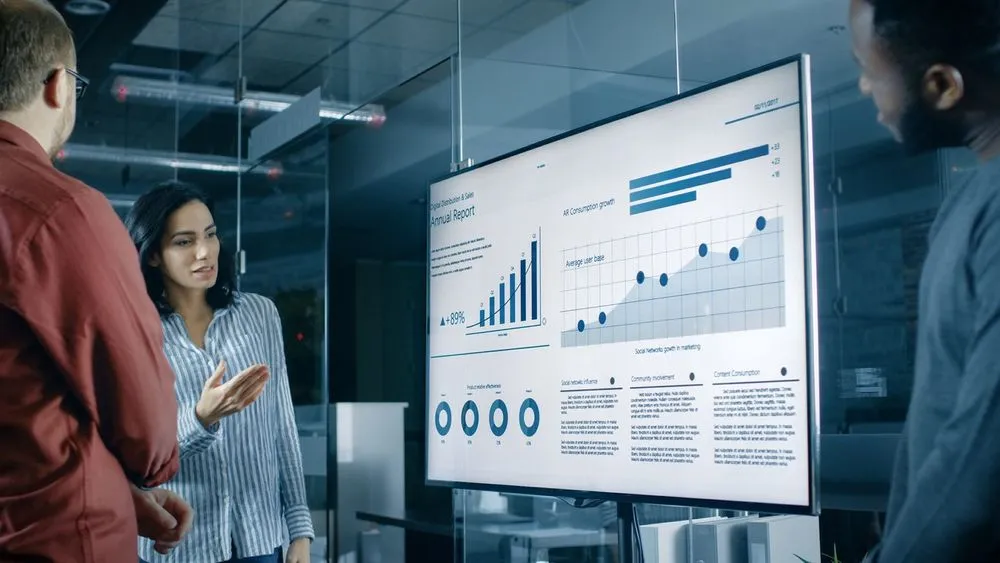Data Visualizations in Azure
Cloud services reduce the hardware and infrastructure costs for businesses The reduction means that capital expenditures and upfront costs go down T...

Cloud services reduce the hardware and infrastructure costs for businesses. The reduction means that capital expenditures and upfront costs go down. Thus, you pay for what you need on an ongoing basis and can easily increase or reduce the amount of service you use. The cloud is especially suited to business intelligence (BI) solutions. With BI, you can bring together data from diverse sources and turn it into raw summaries, reports, analytics, and insights. One of the most valuable features of a BI solution is data visualizations. Seeing it in graphic form lets you quickly see trends and relative quantities and make informed decisions.
Azure Power BI
Microsoft’s Power BI for Azure provides a rich set of tools for analyzing business data. Among its greatest strengths is a wide variety of data visualization operations. It can focus on specific activities or give an overview of your entire company’s performance. Further, its desktop and mobile applications let you view the latest data in graphic form from the office or on the road.
Power BI is integrated with Microsoft cloud applications and databases, so it can bring together all relevant information while observing security requirements. You can track all of your most significant data in one spot and see it updated in real time.
Azure IoT Hub and BI
Many businesses make heavy use of instrumentation to monitor industrial processes and resource usage. Large numbers of devices contribute to the total picture, and Azure IoT Hub coordinates them. Power BI can show data from Azure IoT Hub in graphic form. The required components are an Azure subscription, Azure IoT Hub, and a client application that runs on the device. Then, the client sends messages to the Azure IoT tab in your dashboard.
You can choose from many visualizations, such as a line graph, a power map, or a bar chart. With the right visualization, trends and outages become easy to spot.
Azure Dashboards
To keep you from being overwhelmed by data, Azure Power BI provides a “single pane of glass” view through its dashboards. Thus, customize a dashboard to present the combination of data visualization you need and how you want to show it. Then, share and reset dashboards manually or at set periods.
Dashboards are integrated with Azure Role Based Authentication (RBAC), to ensure that sharing a dashboard doesn’t inadvertently give restricted information to people who aren’t cleared for it.
There are some limitations on data visualizations. Indeed, log charts are limited to 30 days to keep the amount of data from being overwhelming. They can’t have custom parameters and have a limited data series.
Azure Monitor Views
Keeping track of metrics and logs can be challenging. The variety and quantity of information are both huge. Azure Monitor collects this information and makes it available for insights, log analytics, dashboards, and workbooks. Indeed, the Views feature supports the creation of custom visualizations for log data.
Filters are available for specific parameters, and you can export and import views. Make exported Views available to resource groups and subscriptions. The feature doesn’t support metrics, and the layout options are somewhat limited, but Views is, nonetheless, a versatile tool.
Workbooks

For a more dynamic view, workbooks are available. These interactive documents support both metrics and logs. They provide a document-like flow, and creating workbooks from templates doesn’t take programming skills. A template gallery is available on GitHub. The design environment enables collaboration. In fact, any team member with access to the relevant resources can update a workbook. Include interactive features by updating data visualizations as different elements are selected.
Workbooks, unlike dashboards, don’t refresh automatically, and they don’t follow the “single pane of glass” paradigm. They’re document-oriented, serving to get more detailed insights.
Grafana
For isolating operational incidents, Grafana is a valuable addition to Power BI. It’s a third-party open-source observability platform. Further, you can add it as a data source plugin to your Azure subscription and use it to visualize metrics. It supports many data sources and visualizations. Its value for diagnosing incidents lies in the ability to set alerts based on criteria in the data. Support for parameters makes flexible setups possible.
It includes Azure Monitor integration. However, it otherwise does not integrate with Azure. For instance, you can’t use Azure Resource Manager with Grafana dashboards and models.
Visio
For diagramming and vector graphics with Power BI, you can take advantage of Microsoft’s Visio. These graphics can enhance your dashboards with specially designed views that make the meaning of the data clear. Then, by connecting data sources to Visio diagrams, you can see the display update as new data comes in.
Visio lets you make Excel spreadsheets into diagrams and create personalized visualizations. You can design every aspect or take advantage of pre-designed elements. Additionally, templates are available to aid in converting spreadsheets, and designers can create their own templates. Using this feature requires a Visio subscription.
SandDance
Yet another tool for data visualization is SandDance 2019 from Microsoft Research. It’s virtually a new product, a complete open-source rewrite of the earlier SandDance. Further, it’s not an out-of-the-box tool by itself, but a set of components that work in JavaScript or React applications. It’s available as a PowerBI Custom Visual included in other packages. You can create your own applications to generate many kinds of visualizations.
The distinctive concept of SandDance is unit visualizations. Each dataset row has its own graphic element, rather than including an aggregation. This approach lends itself to scatter plots, density plots, and bar charts. Getting the full value of SandDance requires some programming, but it’s an excellent choice for some custom visualizations.
Staying Informed With Azure
With so many options, Azure Power BI plus the appropriate tools can give you almost any kind of data visualization you need. You’ll be able to see the big picture or focus on the details. Migrating to Azure gives you access to Power BI and many other features that will help to keep you informed about the state of your business operations. You’ll be able to collect and visualize the information you need to make the best decisions. Agile IT is a top-rated Microsoft partner, and we understand the complexities when it comes to deploying Azure. To get started with us, schedule a call today for an Azure migration assessment.





